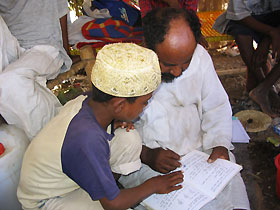(3) The field research lasted from August 2004 to October 2004. During my stay in the field, I was able to investigate the current state of education development in Eritrea, focusing on the impact of wartime education on girls. During this fieldwork trip, I focused on the contradiction or “tug of war” between the Eritrean government’s desire to successfully implement its global and national goals in attaining high enrolment for all children, including girls, in schools, and the community’s resistance and mechanisms for coping with the current shortage of labor. I selected 30 girls who are currently supporting their households.
In doing so, I was able to focus on the current crisis faced by each household. I also conducted detailed case studies of four girls within the 30. These four case studies were selected based on their social representation in Gadien village. In order to measure the change in marriage age, I gave a survey questionnaire to 60 women who had married within the last 14 years.
I discovered that girls in Gadien village were making an important economic contribution to household activities. In some cases they were the primary breadwinners of the household. New responsibilities for girls have increased and most of them fully participated in farming activities and worked as laborers, ran family shops as traders and performed tasks traditionally held by men, including managing fruit farms. Furthermore, they participated in key decision-making processes about the wellbeing of their families. Although they had new roles and responsibilities, they continued to perform their traditional domestic tasks. Moreover, their importance in household activities gave them a powerful tool for bargaining and negotiating their own marriages. Some girls were contributing money to help their siblings to marry or towards their own dowries as well as making decisions on when and to whom they would marry.
Hence, I was able to conclude that, in order to replace lost labor, supplement income and increase productivity, parents were keeping girls at home. In the process the role girls were playing in the community was changing rapidly. Currently girls were making positive contributions to household activities. They were employed as wage laborers to earn money to help their families. They were participating in community life and in household activities as traders. In addition, they were contributing to and participating in making financial and social decisions in household activities, including contributions to their siblings’ bridewealth and dowries.


 21st Century COE Program
-Aiming for COE of Integrated Area Studies-
21st Century COE Program
-Aiming for COE of Integrated Area Studies-